Services on Demand
Journal
Article
Indicators
-
 Cited by SciELO
Cited by SciELO -
 Access statistics
Access statistics
Related links
-
 Similars in
SciELO
Similars in
SciELO
Share
Revista odontológica mexicana
Print version ISSN 1870-199X
Rev. Odont. Mex vol.16 n.2 Ciudad de México Apr./Jun. 2012
Case reports
Lip pleomorphic adenoma
Erick Carrillo Terán,* Ernesto Miranda Villasana§
* Graduate, Maxillofacial Surgery Specialty, Regional Hospital ''General Ignacio Zaragoza'' ISSSTE, Mexico.
§ Service Head, Head of the Maxillofacial Surgery Course at the Regional Hospital ''General Ignacio Zaragoza'' ISSSTE, Mexico.
ABSTRACT
Benign tumors in major salivary glands are frequently found in the parotid gland in 70% to 80% of cases. Pleomorphic adenoma is the most common tumor of minor salivary glands, the palate being a commonly affected site. Other locations for this tumor within the oral cavity are: lips, oral mucosa, gums and tongue. Location in the lips pertains to 25% of all pleomorphic adenoma. This, according to frequency, places them in second place. Upper lips present higher frequency than lower lips.
Key words: Pleomorphic adenoma, lower lip.
INTRODUCTION
70 to 80% of benign tumors found in major salivary glands are located in the parotid gland. Pleomorphic adenoma is the most common tumor of major salivary glands, and the palate is the most commonly affected site.1 Other locations within the oral cavity are: lips, oral mucosa, gums and tongue. Location in the lips pertains to 25% of all pleomorphic adenoma cases. From the frequency point of view this places them in second place. Location in upper lips presents higher frequency than in lower lips.2
The present article reports the case of a patient with pleomorphic adenoma located in the upper lip.
CASE REPORT
27 year old male patient, reporting no history of allergic systemic diseases. He was remitted from his assigned clinic, Iztapalapa ''ISSSTE'' to the Maxillofacial Surgery Service of the Regional Hospital General Ignacio Zaragoza ISSSTE for diagnosis and treatment.
The patient reported an asymptomatic progressive volume increase in the upper lip, ongoing for two years. Upon physical exploration, a volume increase of about 30 x 20 mm was observed. The lesion appeared indurated, mobile, superficial, well circumscribed and when palpated, elicited no significant pain (Figures 1 and 2).

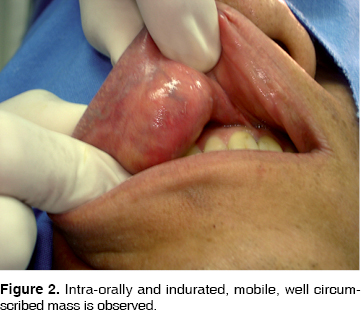
A cytopathological study was selected as initial treatment, using BAAF technique (aspiration biopsy performed with a fine needle). Diagnosis reported was pleomorphic adenoma.
An excisional biopsy was performed under local anesthesia, using 2% lidocaine with epinephrine at a 1:100,000 ratio. A peri-lesional linear incision was performed (Figure 3) and the lesion was totally removed (Figures 4 and 5). The surgical site was cleansed with 0.9% physiological solution and polyglycolic acid suture was put into place.
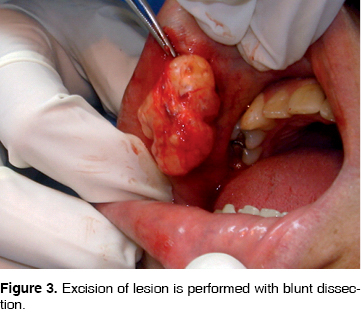

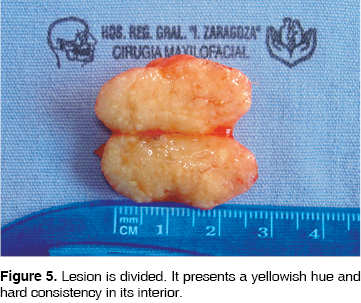
The sample was sent to the laboratory for pathological studies to be conducted. Tests results confirmed the presence of pleomorphic adenoma in the upper minor salivary gland.
The patient was examined one week after surgical procedure. No data on infectious processes were found, and adequate healing of the surgical bed was observed (Figures 6 and 7).
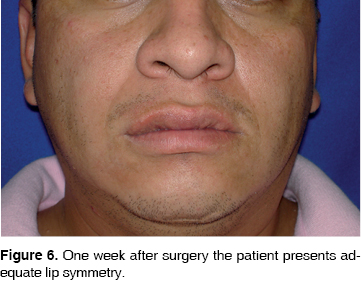
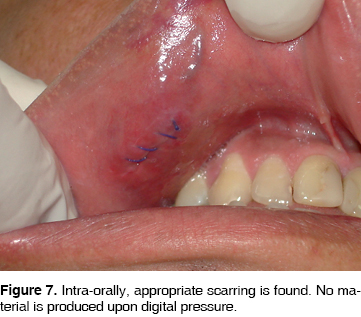
DISCUSSION
Pleomorphic adenoma appears as a firm, painless and slow growing mass that is commonly diagnosed long after the lesion has become present. It can appear at any age, and is more common in subjects with ages ranking from 30 to 50 years.3
Minor salivary gland tumors represent less than 25% of all salivary neoplasia.4-6 Toida et al7 in 2004, conducted a study in 82 patients to determine frequency and distribution of different types of salivary gland tumors. They reported that benign tumors showed predilection for women, and malignant tumors for men. All benign tumors in this study report were pleomorphic adenoma, with the exception of one papillary cystoadenoma. These tumors show clear predilection for women. The male-female ratio was found to be 1:3.2.
Results described in the previous paragraph agree with results reported by several authors such as Eveson and Cawson, who in 19858 informed of a study involving 336 tumors. Waldron et al in 1988,9 Loyola et al in 1995,10 Kussama in 199711 and Wei-Yung Yih in 200512 informed of similar results.
Pleomorphic adenoma most frequently develop, with a ration of 6:1 when compared to the upper lip. The probable reason for this ratio is due to the different embryological development and different trauma risk of both lips. It has been considered that potential tumor cells are destroyed by the continuous presence of inflammatory cells in the lower lip due to their higher incidence of trauma.13
REFERENCES
1. Spencer JM et al. Pleomorphic adenoma of the palate in children and adolescents: a report of 2 cases and review of the literature. J Oral Maxillofac Surg 2007; 65: 541-549. [ Links ]
2. To EWH et al. Pleomorphic adenoma of the lower lip: Report of a case. J Oral Maxillofac Surg 2002; 60: 684-686. [ Links ]
3. Neville BW et al. Oral & maxillofacial pathology . 2nd edition, Ed. Saunders. USA 2002: 410-413. [ Links ]
4. Da-Quan M, Guang-Yan Y. Tumors of the minor salivary glands. Acta Otolaryngol 1987; 103: 325-331. [ Links ]
5. Eveson JW, Cawson RA. Tumors of the minor (oropharyngeal) salivary glands: a demographic study of 336 cases. J Oral Pathol 1985; 14: 500-509. [ Links ]
6. Isacsson G, Shear M. Intraoral salivary gland tumors: a retrospective study of 201 cases. J Oral Pathol 1983; 12: 57-62. [ Links ]
7. Toida M et al. Intraoral minor salivary gland tumors: A clinicopathological study of 82 cases. Int J Oral Maxillofac Surg 2005; 34: 528-532. [ Links ]
8. Eveson JW, Cawson RA. Salivary gland tumors: A review of 2,410 cases with particular reference to histological types, site, age, and sex distribution. J Pathol 1985; 146: 51. [ Links ]
9. Waldron CA, el-Mofty SK, Gnepp DR. Tumors of the intraoral minor salivary glands: A demographic and histologic study of 426 cases. Oral Surg Oral Med Oral Pathol 1988; 66: 323. [ Links ]
10. Loyola AM, de Araujo VC, de Sousa SO et al. Minor salivary gland tumors. A retrospective study of 164 cases in a Brazilian population. Eur J Cancer B Oral Oncol 1995; 31b: 197. [ Links ]
11. Kusama K, Iwanari S, Aisaki K et al. Intraoral minor salivary gland tumors: A retrospective study of 129 cases. J Nihon Uni Sch Denti 1997; 39: 128. [ Links ]
12. Wei-Yung Y. Intraoral minor salivary gland neoplasms: Review of 213 cases. J Oral Maxillofac Surg 2005; 63: 805-810. [ Links ]
13. Krolls SO, Hicks JL. Mixed tumors of the lower lip. Oral Surg 1973; 35: 212. [ Links ]
Note  Mailing Address:
Mailing Address:
Erick Carrillo Terán
E-mail: erickcarrilloteran@hotmail.com
This article can be read in its full version in the following page: http://www.medigraphic.com/facultadodontologiaunam











 text in
text in 


